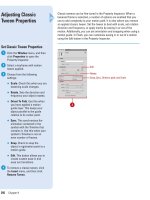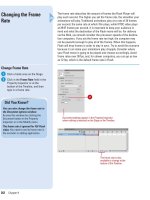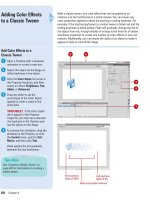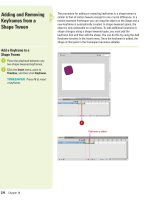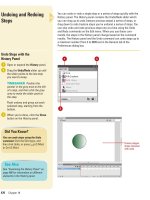Tài liệu Thiết kế flash với flash cs5 part 84 pptx
Bạn đang xem bản rút gọn của tài liệu. Xem và tải ngay bản đầy đủ của tài liệu tại đây (683.54 KB, 6 trang )
ptg
510
Chapter 21
Creating an Adobe
AIR Application
Create a New Adobe AIR
Document
Click the File menu, and then
click New.
TIMESAVER
Click Adobe AIR 2
on the Welcome screen to create
a new blank document.
Click the General tab.
Click Adobe AIR 2.
Click OK.
Create your application in Flash.
Click the File menu, and then click
Adobe AIR 2 Settings.
Click the General, Signature,
Icons, and Advanced tabs to
select or create a digital
certificate and other AIR
publishing settings.
Click Publish, and then click OK.
8
7
6
5
4
3
2
1
2
3
4
Adobe AIR is a cross-operating system runtime that allows you to lever-
age your existing web development skills in Flash to build and deliver
Rich Internet Applications (RIAs) to more devices, including the web,
mobile, and desktop. You can create a new Flash file for AIR from the
Welcome page or the New dialog box by clicking Adobe AIR 2 (
New!
),
or use an existing Flash file (ActionScript 3.0), and then convert it to an
Adobe AIR file through the Publish Settings dialog box (
New!
). Before
you can publish a file to Adobe AIR, you need to have a digital certifi-
cate that represents the application publisher’s identify. After you pub-
lish an AIR application, you can install it by using the Installer Package
with the AIR extension and start the program like any other program on
your system. When you no longer want to use it, you can remove it like a
normal program too.
See Also
See “Specifying Adobe AIR Options”
on page 482 for more information on
specific publishing settings.
From the Library of Wow! eBook
ptg
Chapter 21 Working with Projects and Other Programs
511
Install and Start an Adobe AIR
Application
In Windows Explorer (Win) or
Finder (Mac), navigate to the
folder with the published AIR
application.
Double-click the installer program
for the AIR application (.air), and
then follow the installer
instructions.
Use the Start menu or Windows
Explorer (Win) or Finder (Mac) to
start the AIR application.
To remove the AIR application, use
the Uninstall a program link in the
Control panel (Win) or drag the
application folder to the Trash can
(Mac).
4
3
2
1
1
2 3
Digital certificate file
Did You Know?
You can access gesture events in
ActionScript.
Adobe’s AIR 2.0, built on
the same technology framework as
Flash, introduces a new set of events
that detect when you touch the screen
called gestures. Gestures can also be
used in the new Flash iPhone
Packager.
From the Library of Wow! eBook
ptg
512
Chapter 21
Flash content deployment is expanding from the Web to other mediums,
such as cell phones, PDAs, and other mobile devices. In conjunction
with Adobe Device Central CS5, Flash allows you to create and test
content for mobile devices. You can use the New Document dialog box
to create a blank Flash document for mobile devices using Adobe
Device Central. Flash uses the right settings from Device Central to cre-
ate the content you want. To display content on mobile devices, Flash
uses Flash Lite, a specialized player for mobile devices. After you cre-
ate your mobile content, you can test it using Adobe Device Central and
Flash Lite.
Creating Content for a
Mobile Device
Create a Document for a Mobile
Device
Click the File menu, and then
click New.
Click the General tab
Click Adobe Device Central.
Click OK.
Adobe Device Central CS5 opens,
where you can select the device
and any options you want.
4
3
2
1
2
3
4
From the Library of Wow! eBook
ptg
Chapter 21 Working with Projects and Other Programs
513
Select the device you want and
check the device profile for
support and compatibility issues.
Click Create.
The new document appears in
Flash, where you can develop your
content.
6
5
6
5
Device Library tab with device information
From the Library of Wow! eBook
ptg
514
Chapter 21
Every day the world is getting smaller, and mobile devices are getting
smaller, and smarter. Using Flash, you can include event sounds when
creating documents for playback on mobile devices. Flash does not
support sound file formats used for mobile devices (such as MIDI and
others); when authoring for mobile devices, you must temporarily place
a proxy sound in a supported format such as MP3 or WAV in the Flash
document. The proxy sound in the document is then mapped to an
external mobile device sound, such as a MIDI file. During the document
publishing process, the proxy sound is replaced with the linked external
sound. The SWF file generated contains the external sound and uses it
for playback with Flash Lite on a mobile device. Flash Lite is the Flash
Player for mobile devices.
Mapping MIDI Sounds
on a Mobile Device
Map MIDI Sounds on a Mobile
Device
Click the File menu, point to
Import, click Import to Library, and
then import one or more sounds
into the Flash Library.
Control+click (Mac) or right-click
(Win) the sound you want to work
with, and then click Properties.
Enter a path to the location where
the mobile device sound is
located.
Click OK.
Add a button instance to the
Stage.
IMPORTANT
You can use a
pre-made Flash button. Click the
Window menu, point to Common
Libraries, and then click Buttons.
Open the button in the Library, and
then add the linked sound to the
Hit frame of the button.
Click the File menu, and then click
Publish Settings.
7
6
5
4
3
2
1
2
4
3
6
5
From the Library of Wow! eBook



